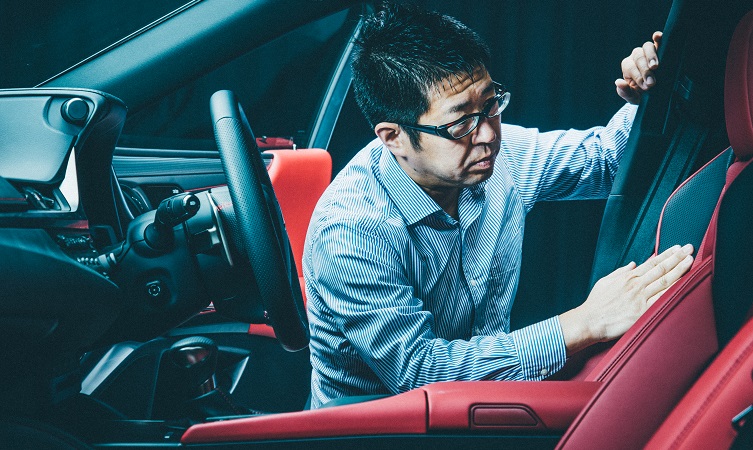Lexus has always been known for outstanding build quality and precision craftsmanship, both inside and out of every vehicle within the range. Here, we take a look at some of the unique features that make up the new Lexus ES interior and why it stands out from its mainstream competitors.
Lexus ES interior: are you sitting comfortably?
Lexus considers good seat design to be a critical part of any new car’s development. It took three years to produce the perfect seats for the all-new ES saloon, a process that involved numerous prototypes in the search for a design that provides ideal support and comfort for people of all shapes and sizes.

The overarching concept for Lexus seat design is Clear and Deep, as leading engineer Takeshi Kawano (above) explained: “The moment you sit in the new ES, you’ll notice that your posture feels just right. There’s no need to squirm around until you find the right position. This is the clear part.
“Then, once you’re seated, your lower back is fully supported. You’ll feel at ease and no matter the G-forces acting on the car from any direction, your posture never wavers. This is the deep part.”
Achieving the right results takes time and attention to detail, ensuring that a high level of comfort is matched by durability. The driver’s seat must also be able to convey the forces acting on the car and its movement, without exposing the driver to unpleasant vibrations.
The seats had to be designed to suit occupants of all sizes, which presented the team with another significant challenge.

“No matter how big or small the driver is, they should be able to experience the exact same sense of luxury,” said Shin Maezawa (lead image), who leads all Lexus seat development. “Our biggest dilemma during development was how to design the seats so they could effectively cancel out physical differences.”
The ES’s seats have a simple structure, with polyurethane foam wrapped around a metal frame. The cushion is flat but the sides are elevated to provide hip support and keep the body stable. However, if the cushion is made wide enough for large drivers to sit snugly in the seat, smaller drivers will experience a lack of support around the hips.
“To develop a seat cushion that cancels out physical differences, we incorporated very subtle depressions in the surface so that even smaller body types can sink firmly into the seat,” Kawano explained. “We also added a laminated layer to the top of each seat. This layer is thin and soft, which allows the head to sink into the cushion for better stability.”
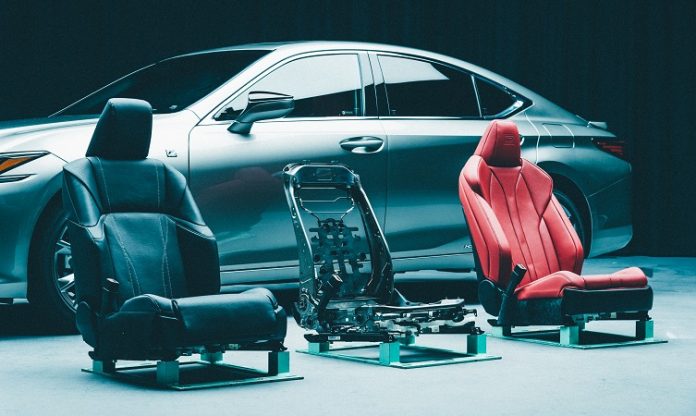
Lexus ES F Sport seats
For the ES F Sport model, the designers looked to create something that would provide even greater body holding, taking the seats in the Lexus LC flagship coupe as inspiration.
“When designing seats for an F Sport car, qualities need to be set at a much higher level than in a standard model,” Kawano said. “This allows the driver to feel that much more secure. To provide exceptional snugness and posture stability, we designed the seats to conform to the body type of the driver or passenger.”
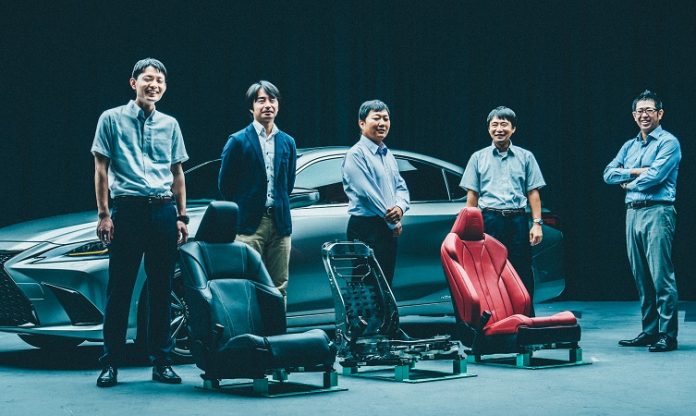
Kawano and his team also increased the resilience of the side support, which protects the body from G-forces that act on the car when cornering at high speeds. They also designed the seats so that the hips, back, and shoulders are stabilised against a single surface.
Kawano added: “It’s because the ES F Sport is such a sporty car that I felt we needed to stabilise the driver’s body so that they wouldn’t move at all, even when driving on a racing circuit at full speed. We’ve tested the seats, and we can tell you that even when going around a corner at high speeds, the driver’s position barely changes.”
Lexus ES interior: inspired by katana sword-making
Lexus design is distinguished by the way it seamlessly combines contemporary styling cues with luxury materials, flawless finishing and references to traditional Japanese craftsmanship. The new Lexus ES 300h F Sport continues this approach with the availability of a distinctive new interior trim inspired by traditional sword-making techniques.
This hadori trim is directly inspired by the centuries-old craftsmanship techniques used to make the katana, the famous long-bladed curving sword used by Japanese samurai warriors. Lexus recruited skilled artisans to create the special finish, then used precise machine programming to replicate their work in fine detail.
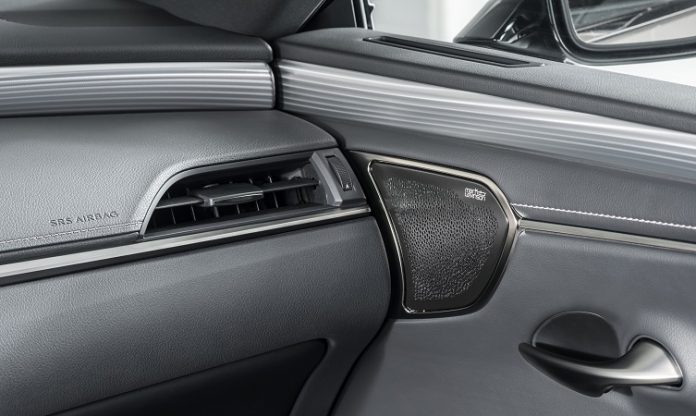
The project was led by Toshihide Maseki, who designed the car’s interior. His research took him to the city of Seki, Japan’s historic centre of katana manufacturing. Seeing for himself the traditional metalworking process, he realised that hadori, the polishing technique that gives each blade its individual quality and character, would add to the dynamic and elegant look he wanted for the new ES F Sport’s cabin.
“I was most surprised by the incredible visual impact of the hammers hitting the metal during the forging process,” Maseki said. “A tremendous amount of power goes into shaping the metal into a blade. However, although a just-forged blade possesses a raw and tangible intensity, it’s missing the elegance that the new ES F Sport required. That’s when I turned to the next step in the process, the polishing. Hadori is a technique used to polish a blade into a singular work of art, and I felt that this fitted the design concept of the new ES.”
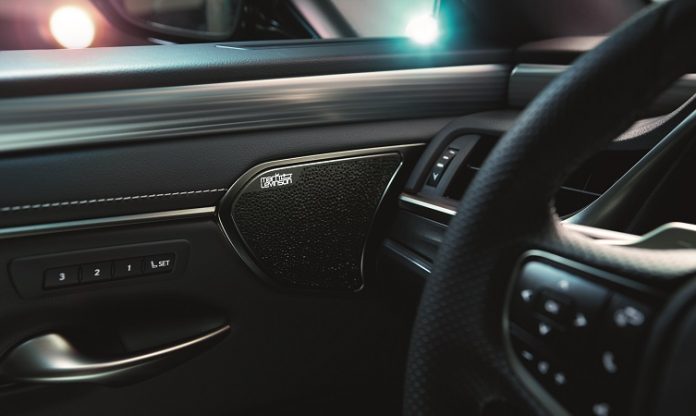
Replicating the artisan’s masterwork
Maseki focused on the simple, un-ornamented look of pre-17th Century katana blades. Once he settled on a concept and design direction for the door trim, skilled artisans crafted a prototype by hand; this could then be replicated using a machine. Although the equipment was fed precise data related to the details of the hadori pattern, the results did not match the look of the prototype.
Maseki explained: “Studying the pattern with a microscope, I discovered randomly created lines that could not be replicated with a machine. But these lines gave the overall design its powerful impact.”
These ‘random lines’ had been instinctively added by the craftsmen, bringing to bear their many years of experience and keen understanding of katana aesthetics.
“Although being refined is an important quality in craftsmanship, a product is incomplete without the addition of more instinctive, human elements that are not based on a simple calculation,” said Maseki. “Being machine-made but artisanal, being refined but having an impact. These may seem like contrasting elements but through a lot of trial and error we were finally able to achieve this combination, in the process imbuing the door trim of the new ES with deep katana-like beauty.”
Lexus ES interior: where tranquillity meets excitement
There is something unnerving, even suffocating, about the complete lack of noise created in a soundproof space. The silence is so ‘loud’ that it fails to provide the relaxing environment normally associated with quietness.
The same applies to the silence inside a car. Although low noise levels are important in a luxury vehicle, allowing the occupants to enjoy music and conversation without difficulty, quietness should not be mistaken for a complete lack of sound. Creating a quiet atmosphere is actually about allowing sounds that are pleasing to the ear to flow freely while doing everything possible to suppress unpleasant noises.
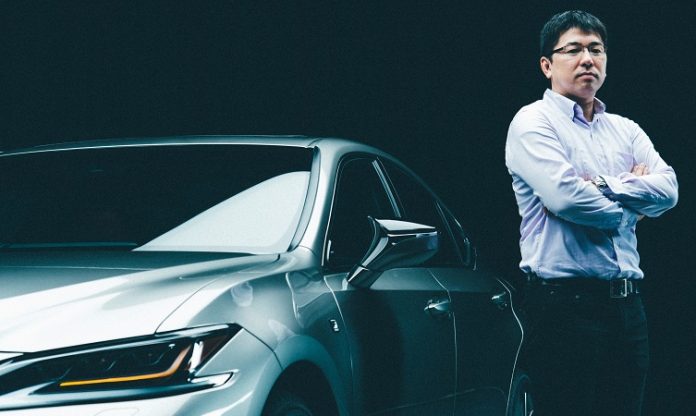
Lexus ES: quiet but not soundless
“Every generation of ES has had a reputation for offering an impressive level of quietness,” confirmed Hirotaka Tsuru, who designed the noise, vibration and sound controls of the new Lexus ES. “Naturally, we considered a quiet cabin to be the most important feature when developing the latest model. The LS served as our benchmark for this project.
“Quietness is not a quality that can be improved by simply blocking out more noise. For example, we developed a test model that greatly suppressed bandwidths around 1.0kHz – the range most readily picked up by our ears. But doing so raised the air density inside the car and caused ringing in the ears, even nausea – not relaxing at all.”
To ensure the Lexus ES interior inherited the right aural quality, Tsuru divided the development into three areas.

1. Noise source elimination
Tsuru incorporated wind tunnel testing – more commonly employed in reducing air resistance – early in the development of the ES to pinpoint every source of wind noise. He tested the car under a number of different circumstances, making tiny adjustments in the position of the mirrors, wiper arms and other car parts.
“The advantage of using the Lexus wind tunnel is that it is a laboratory designed for testing low-noise levels,” Tsuru continued. “This means we can quantitatively measure the wind noise level while controlling interior noise levels and interior noise sources.”

2. Sound insulation
Next, Tsuru focused on sound insulation as a way of reducing the level of noise entering the car. This phase involved cutting off passages through which noise could enter, and filling or sealing openings in areas such as the floor and inner areas of the boot lid.
“From the time we began to develop the new platform, we were already studying ways to reduce the number of openings and considering covering the entire floor with silencers, which in previous models had only been placed on some parts of the floor. In other words, the new ES represents our effort to greatly improve the specifications of the base car.”

3. Noise absorption
In the third phase, Tsuru turned his attention to noise absorption, applying absorption material to the suspension towers, inner arches, undercarriage and other areas.
Factors such as road conditions are always difficult to account for when designing a car. Although you cannot fully prepare for changes in external factors, failing to account for certain bandwidths may result in those sounds being more perceptible than usual – in other words, an even noisier car.
“Changes in the environment are most often caused by natural winds and changes in the road condition. We needed to incorporate these factors into the design in order to produce a pleasing aural environment in which every type of sound – both good and bad – is precisely adjusted. It was a difficult process that required a lot of patience.”
All information is correct at the time of publishing.
